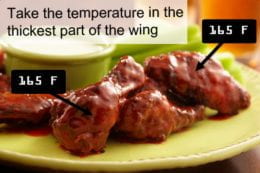 Chicken wings are very popular. But Salmonella has been the spoiler due to improper cooking. Many cooks do not use a food thermometer or just use visual clues for doneness. The recommended internal temperature for all poultry products is 165°F.
Chicken wings are very popular. But Salmonella has been the spoiler due to improper cooking. Many cooks do not use a food thermometer or just use visual clues for doneness. The recommended internal temperature for all poultry products is 165°F.
A validation study, conducted at the University of Nebraska-Lincoln and published in the Journal of Food Science, was designed to determine the thermal lethality of Salmonella on fresh chicken wings cooked in a conventional convection oven and in an air fryer, two popular dry heat cooking methods. The goal was to validate cooking times and temperatures to guide consumers in safely cooking chicken wings.
Chicken wings were inoculated with a five-strain cocktail of Salmonella, then cooked in each appliance for 2, 5, 10, 15, 20, 22, or 25 minutes and at actual temperatures of 288.5°F-298.2°F in the convection oven and 340.7°F-364.5°F in the air fryer. In the end, all cooking times below 22 minutes still tested positive for Salmonella. Recipe sources can benefit with using this information to guide consumers to safely cook chicken wings.

